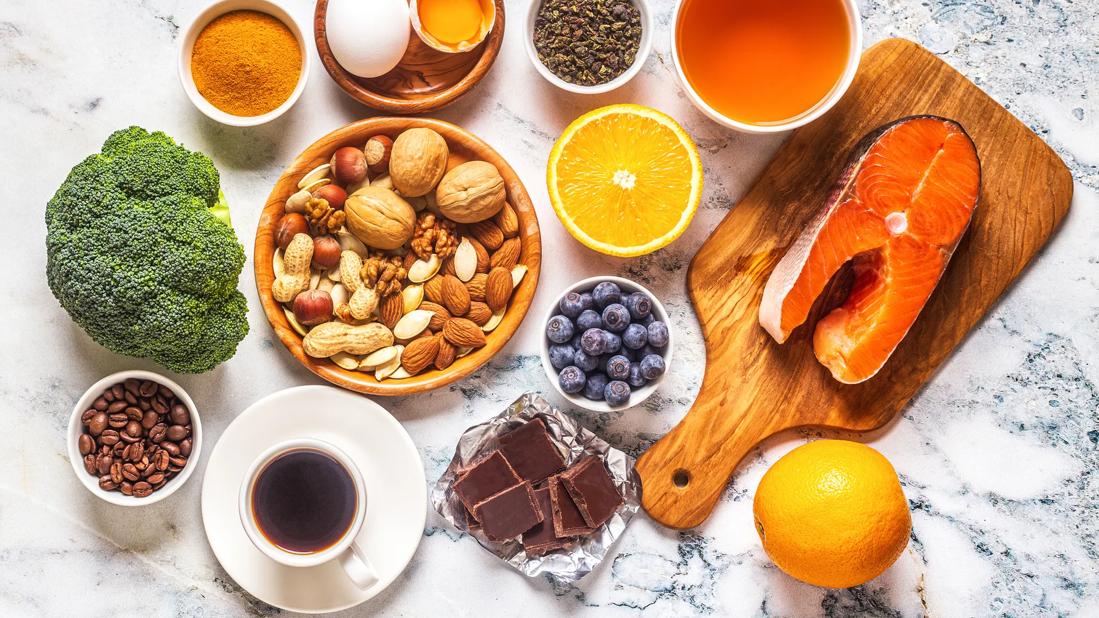Eat fruits, vegetables, legumes, whole grains, lean proteins and healthy fats to help manage symptoms of this degenerative brain condition

If you have Parkinson’s disease, you may feel overwhelmed by diet advice. Some sources may tell you to eat certain foods and to avoid others. Some may even claim that specific foods are miracle cures for your symptoms.
Advertisement
Cleveland Clinic is a non-profit academic medical center. Advertising on our site helps support our mission. We do not endorse non-Cleveland Clinic products or services. Policy
So, what should you eat with Parkinson’s disease?
Neurologist Hubert Fernandez, MD, says some information about Parkinson’s disease and foods is based on outdated or inaccurate research — or may not even have any science to back it up.
But there’s some solid advice when it comes to your diet. Dr. Fernandez explains what you should know about the foods you eat when you’re living with Parkinson’s.
Fruits, vegetables, legumes, whole grains, lean protein and healthy fats are reported to reduce inflammation and promote good health and longevity for anyone — with or without Parkinson’s disease. Here’s what to fill your plate with.
When it comes to adding fruits and vegetables, you want to include options that are colorful like citrus fruits, tomatoes, leafy greens and berries. Fruits and vegetables are a good source of antioxidants, vitamins and minerals.
Fruits like apples, blackberries and raspberries, as well as vegetables like artichoke hearts, avocados and broccoli, are great sources of fiber. And a high-fiber diet is a proven way to avoid constipation, a common problem for people with Parkinson’s disease.
“Parkinson’s can slow down the intestines and cause constipation,” Dr. Fernandez says. “Fiber helps keep things moving.”
Advertisement
Another high-fiber food that’s helpful in avoiding constipation? Legumes. Think beans, peas and lentils. Legumes are also a good source of plant-based protein.
And you may have heard that fava beans, a popular legume, contain an amino acid known as levodopa. Levodopa is an active ingredient in some Parkinson’s disease medications. Seems like a good reason to eat a lot of fava beans, right?
Nope, says Dr. Fernandez. You’d need to eat a lot of fava beans every single day to even come close to the same amount of levodopa in a pharmaceutical-grade pill.
But supplementing your diet with fava beans could elevate dopamine levels and also improve constipation.
“Overall, eating fava beans is a good thing, but not as a substitute for medications,” he stresses.
Whole grains are another great way to go to get your daily fiber intake. The benefits of whole grains include avoiding weight gain, improving your gut health and improving your cholesterol.
Whole grains include oatmeal, brown rice, quinoa, spelt, farro and sorghum.
Choose lean protein options like fish, poultry, eggs and beans.
If you’re taking a levodopa medication, your doctor may advise you to avoid protein when taking your meds. Both animal and plant protein can interfere with the absorption of levodopa medications.
But you should still eat plenty of protein. Just be strategic with the timing.
“For some people, taking levodopa medication with meals lessens the absorption of the drug, making them less efficacious [effective],” shares Dr. Fernandez. “If you notice that the effect of your medication doesn’t seem to last when taken with food, it’s best to take it with an empty stomach — either 30 minutes before your meal or a couple of hours after eating.”
If you get nauseous from the medication, eat a small amount of starchy food with it, such as crackers. Make sure whatever you eat with your medicine doesn’t have protein.
“It’s a misunderstanding that people with Parkinson’s should avoid protein,” he adds. “You definitely need protein in your diet to help keep your muscles strong. Just don’t eat it when you’re taking your levodopa medication.”
Not all fat is bad. You want to eat foods that are good sources of omega-3 fatty acids. Consider adding options like salmon, soybeans, kidney beans and flaxseeds to your meals.
Nuts and nut butters are also good sources of monounsaturated fat, which can help reduce your total cholesterol.
People with Parkinson’s disease are at a significant risk of falls, fractures and osteopenia. So, Dr. Fernandez suggests eating calcium-rich foods like low-fat yogurt, Greek yogurt, spinach, broccoli, chia seeds and almond milk.
Advertisement
Additionally, if you have Parkinson’s disease, you’re more likely to have nutritional deficiencies. You may not get enough iron, zinc, vitamin B, vitamin D or calcium from your diet.
“People with Parkinson’s disease can be prone to neuropathy because of low vitamin B6 or B12 levels,” explains Dr. Fernandez. “Fortunately, protein-rich foods such as meat, fish, eggs and dairy are also rich in vitamin B.”
While there are foods you should add to your diet, there are also ones you should avoid. Dr. Fernandez recommends avoiding foods that contain the following:
He also notes that there are varying reports on how a high-fat diet or the use of cholesterol-lowering drugs may contribute to your risk of developing Parkinson’s disease.
One thing you shouldn’t avoid? Salt. If you have Parkinson’s disease, you actually need salt.
“Many people with Parkinson’s have orthostatic hypotension,” Dr. Fernandez says. “This drop in blood pressure happens when you get up from sitting or lying down. The heart and blood vessels don’t respond as quickly as they should, causing you to get lightheaded or pass out. You can fall and get injured.”
But talk to your doctor before you start eating more salt.
Advertisement
And as your Parkinson’s disease progresses, you may experience trouble chewing or swallowing certain foods. In that case, you may need to adjust your diet to include soft and easy-to-swallow foods, like mashed or pureed vegetables or fruits, soups, stews and smoothies.
While a healthy diet won’t cure your Parkinson’s disease, it can go a long way toward helping you manage your symptoms — along with other lifestyle changes, like exercise and reducing stress.
When it comes to a meal plan for people with Parkinson’s disease, there isn’t one exact diet that’s recommended. But certain ways of eating, such as the Mediterranean diet and the MIND diet, may be worth considering.
Also, Dr. Fernandez says to keep in mind that people with Parkinson’s disease are living longer thanks to advances in treatment.
You may want to add foods to your diet that can help lower your risk of developing other neurodegenerative illnesses, such as Alzheimer’s disease (the Mediterranean diet and the MIND diet are good options), cancers and cerebrovascular illnesses like stroke and heart attacks.
Consider working with a registered dietitian to create an eating plan that works for you and your needs.
Advertisement
Learn more about our editorial process.
Advertisement

Poor air quality, pesticides and chemicals — along with genetic factors — can increase your risk of this brain condition

While depression and anxiety are common and can worsen other symptoms, focusing on your emotional health can help

Why seeing a neurologist can save you time and money

This color additive, found in many pre-packaged foods, may affect people with ADHD or allergies

Eating too much salt can put extra pressure on your blood vessels and heart

Tart cherry juice contains natural compounds that may support better sleep

This fruit has clear nutritional benefits — but there’s little evidence it can prevent or treat illness

Great sources of this essential mineral include potatoes, squash, lentils and avocados

The ‘sunshine vitamin’ is found naturally in some fish and is added to other foods

Autism and ADHD often go hand in hand, giving rise to the term AuDHD

The Yuzpe regimen is less effective than other forms of emergency contraceptives, and it’s associated with more side effects